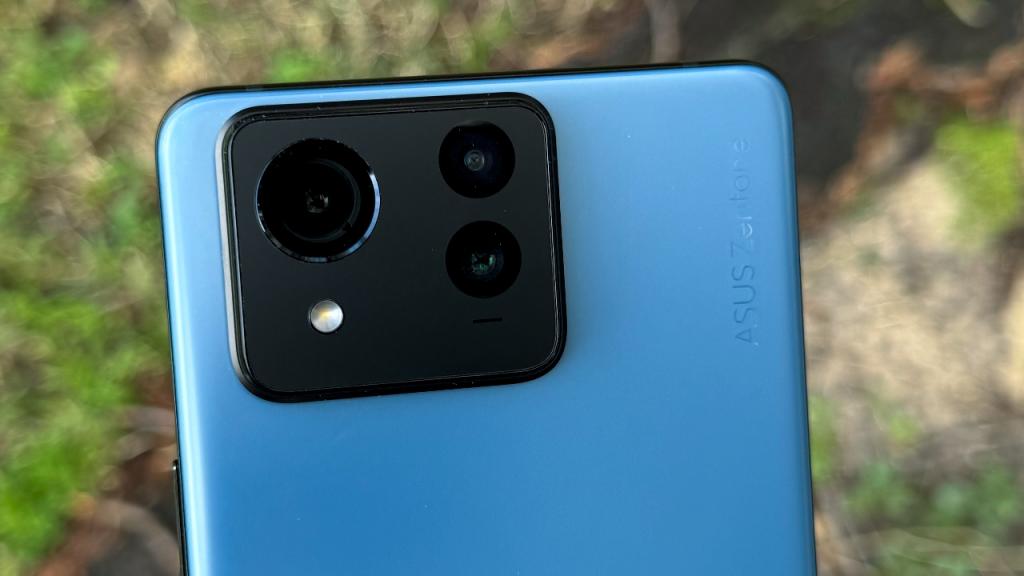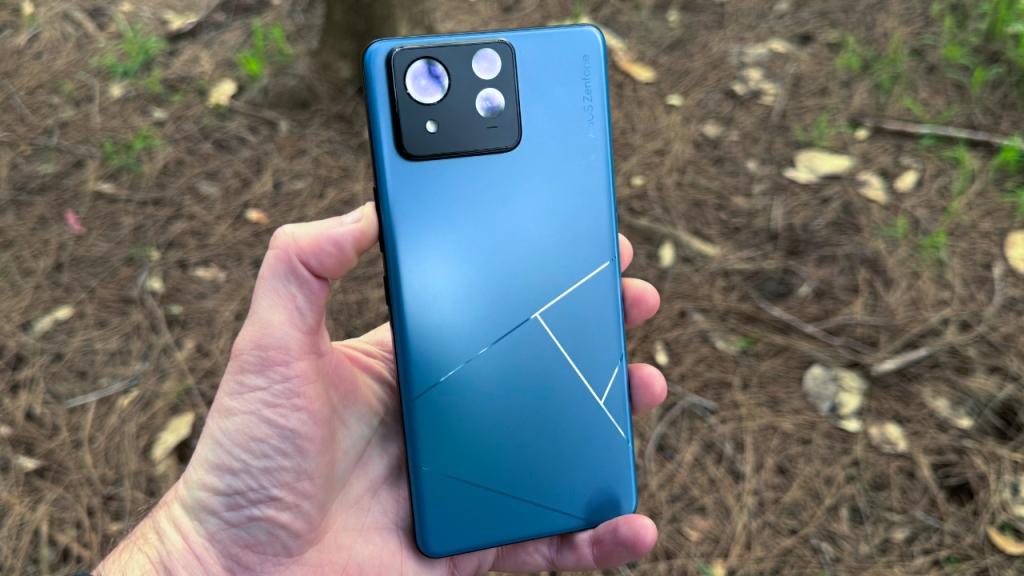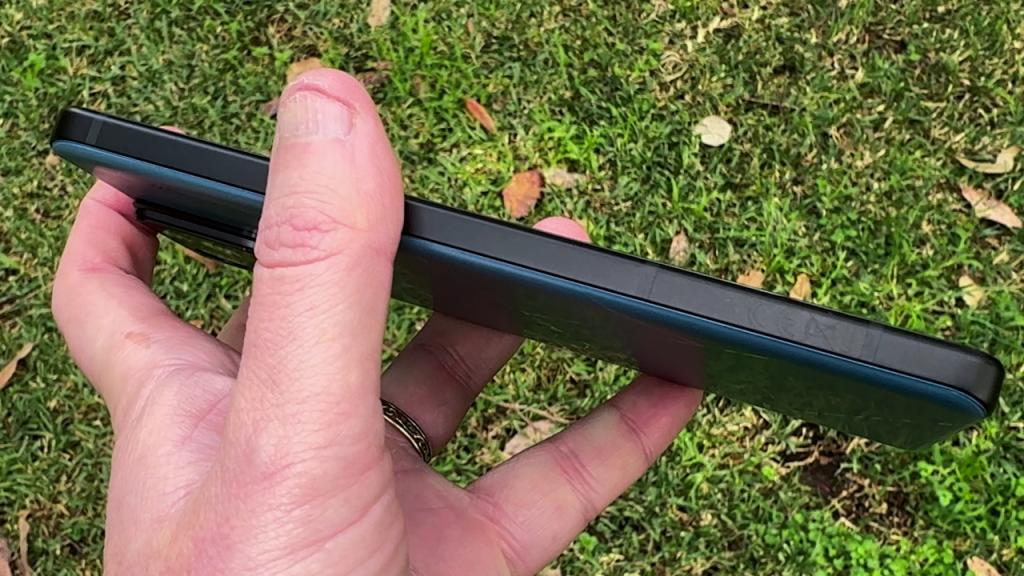My prior experience of reviewing Asus Zenfone models always left me fairly happy, largely because the models Asus released here were smaller, more powerful Android handsets. There are so many Android phones to choose from, but if you want small and powerful, you’re often left wanting. The Asus Zenfone 11 Ultra is powerful, but there’s no way I can describe it as small.
Built around a 6.78 inch 144Hz capable AMOLED display, this is a big phone that carries a premium price, putting it firmly up against other excellent flagships like the Google Pixel 8 Pro or Samsung Galaxy S24 Ultra.
Front-facing bezels are minimal, and like just about every other premium flagship, unlocking is via an in-display fingerprint sensor that gave me no grief during my review period.

So far, so big – and big isn’t bad – but scale does bring with it a few problems, and that’s far more evident once you flip the Zenfone 11 Ultra over.
There, you’re faced with a design in either blue or black that very much looks like it’s come from the ROG family of phones, with angular lines at the back that are purely decorative as far as I can tell – I don’t think Asus is quite so wacky as to throw antennae wires behind them, essentially speaking – sitting beneath what I can only call a camera block.
Other phones have camera bumps, the Google Pixel has a camera bar, but the Zenfone 11 Ultra has a camera block in a big chunky rectangle at the top left side.

There’s some clever engineering here because you’d think this would lead to a phone that might seriously wobble every time you put it down on a table, but it instead sits solid as a rock each time. However, it does stand out, especially against the slick back of the Zenfone 11 Ultra.
That slick back is where the Zenfone 11 Ultra’s size plays against it, because this is one slippery phone that will all too easily get out of your grasp or (as happened to me during the period of this review) slide out of a jeans pocket and under your car seat.
I suppose it is to the credit of its Gorilla Glass Victus cover that this didn’t damage the phone in any way, but I still don’t like dropping phones. I know I honk on a lot at people about the value of phone cases, but here it’s an absolute necessity. Asus does provide a very slender case in the box that doesn’t do a whole lot to change the grip situation, so I’d suggest anyone keen look into a third-party case.
The Zenfone 11 Ultra isn’t like other flagship phones at the base, either. That’s where you’ll find its dual Nano-SIM card slots – not unusual, though oddly at the premium tier there’s no eSIM support – but also USB-C stuck off to the left-hand side, probably a hangover from the ROG phones that lean that way for gaming peripherals, plus a full 3.5mm headphone jack if you’re still the wired headphone type. This is probably the most expensive phone you can buy right now that still has a 3.5mm headphone jack.
Not quite premium cameras – but close
Asus’ track record for cameras on its phone hasn’t been a stellar one – which isn’t to say it’s put bad camera modules on its handsets, more simply that it’s never quite blown me away relative to the best in the field. While the Asus Zenfone 11 Ultra’s $1,599 price point is quite competitive in the premium flagship space, it’s still on the pricey side, and pricey phones have good cameras, right?
The Zenfone 11 Ultra certainly gives it a solid try, with a triple camera array at the back, comprising a 50MP wide lens, 13MP 120˚ ultra-wide and 32MP 3x Optical Zoom Telephoto array hiding in that big camera block, while the holepunch at the front houses a 32MP selfie sensor.
One reason why the camera block at the back protrudes so much is because the primary lens features an inbuilt gimbal stabiliser for more steady shots. That’s most readily apparent if you’re shooting video with the Zenfone 11 Ultra than anything else, though it can come in handy in some lower-light situations.

Otherwise, the rear lenses present generally well, though I did hit a few issues with slightly odd focusing in some shot situations, or where Asus’ default camera app made some unusual exposure decisions for some shots. As with many phones, there’s also a slight tendency for oversaturation of colours in post-processing.




At the front, the Zenfone 11 Ultra’s selfie camera works quite well. Its standard selfie is actually a crop, as it offers a “wide” selfie option despite only having a singular front lens, along with predictable AI-led portrait blur effects.

Overall, while I’d argue that the Zenfone 11 Ultra doesn’t quite reach the highs of a Galaxy S24 Ultra or iPhone 15 Pro Max – and I’d love to be able to do a shootout between the three, though that wasn’t possible during my review period – it does shoot better than previous Asus phones I’ve tested with, especially if you’re keen on using the inbuilt gimbal for video shooting purposes.
Premium CPU for less
Asus has, rather predictably, gone for best of breed under the hood for the CPU, which at the time of writing is Qualcomm’s Snapdragon 8 Gen 3 paired up with (for the model reviewed) 16GB of RAM and 512GB of storage. One word of caution here, because the $1599 list price for the Zenfone 11 Ultra – which is what you’ll find on sale through Asus or JB Hi-Fi right now – is the slightly lower spec 12GB RAM/256GB storage model.
In benchmark terms, the Zenfone 11 Ultra was an interesting device to test. The moment I threw Geekbench 6’s CPU test at it, for example, it decided it would drop itself into its High Performance mode, chewing up extra battery in return for faster CPU speeds. Benchmarking juicing?
Maybe a little, but it’s entirely upfront about it, and it did allow me to test it at its best and worst performance levels to gather a slightly wider performance picture. For Geekbench 6’s CPU test, that meant scores of 2217/6950 (Single Core/Multi Core) dropping to just 1184/4160 in “Ultra Durable” (AKA battery saving) mode.
On the GPU front, its Adreno 750 GPU managed 3106 in 3DMark Wild Life Extreme – not superb for a Snapdragon 8 Gen 3 phone, but remember that’s in low power mode – and if you want to push that processor up to High Performance mode, that figure jumps to a much more pleasing 5244.

For comparison purposes, back when I tested out the Galaxy S24 Ultra, it cracked 4749 in the same test, though I don’t think Samsung’s quite pushing the performance envelope for the S24 Ultra in quite the same way that Asus is doing here.
All of this, not surprisingly, leads to a phone that’s very slick in operation with any app you’d care to throw at it. That is 100% the story for flagship Android phones right now, because there’s really so very little that truly pushes them hard in a processing sense. The Zenfone 11 Ultra’s display can manage up to 144Hz, but that’s a matter for a relatively small number of flagship games and not much more; most of the time you’ll be pushing 120Hz at most.
Asus does provide some tweaks, and being Android, they’re customisable. Want a split notification and controls blind the way that iOS does it? That’s part of Asus’ launcher in a style it calls “Asus Optimised Enhanced”, though you can go for a less split style (“Asus Optimised”) or just Stock Android if you prefer.
Plenty of Android phone makers have opted for increasing lengths of Android phone update coverage – but it kind of feels like nobody bothered to tell Asus this.
While both Samsung and Google offer 7 years of OS upgrades on their flagships, the Zenfone 11 Ultra only gets two OS updates and four years of security updates. Do better, Asus – your competition certainly is.
Battery for days, or gaming, but not both
The Asus Zenfone 11 Ultra is a big phone – did I mention that yet? – and all that phone space means that there’s plenty of space under the glass for Asus to cram in battery capacity. It’s a trick it’s used for some of its ROG phones previously, going above and beyond the near-stock 5,000mAh sealed batteries you find in most Android phones. For the Zenfone 11 Ultra, that equates to 5,500mAh battery instead.
I didn’t have a fresh Galaxy S24 Ultra to side-by-side test with, but back when Zac reviewed it, using Avengers: Endgame as a battery test, that phone went from 92 per cent to 81 per cent to 69 per cent over three hours of battery testing.
The Zenfone 11 Ultra laughs at those figures – and it can afford to, given it didn’t even lose a single percentage point of its 5,500mAh battery for the first hour of Avengers: Endgame’s run time.

No, that doesn’t mean it didn’t use any power; it just means that it’s an exceptionally battery-efficient system for video playback, dropping to just 96 per cent after hour two and 91 per cent for hour three. That’s truly exceptional flagship battery performance there, for sure, as long as you’re using it as a movie watching platform.
Drop it into more challenging gaming scenarios, and you’re back in more familiar territory of a battery that can last a day on moderate usage without ease, but also one that can go flat if you have to engage in just one… more… battle…
Charging is via USB-C at up to 65W or via standard Qi wireless charging, but you’ll have to bring your own charger to the party; here Asus has very much gone down the premium orthodoxy line here by not including one in the box.
The Verdict: Should you buy the Asus Zenfone 11 Ultra?
While I pretty obviously haven’t hidden my disappointment in the lack of a true compact flagship from Asus here, I can’t ignore that for the most part the Zenfone 11 Ultra does present decent value.
Battery life is an obvious standout, and overall performance is good, going toe to toe with Samsung’s best at a much lower price point, even allowing for the fact that we’re starting to see regular discounts on the Galaxy S24 Ultra come into play.
Conversely, it’s not quite up there in camera terms, it’s slippery in the hand and it is disappointing to see a true flagship phone ship with just two years of Android OS upgrades provided in 2024.
Image: Alex Kidman
